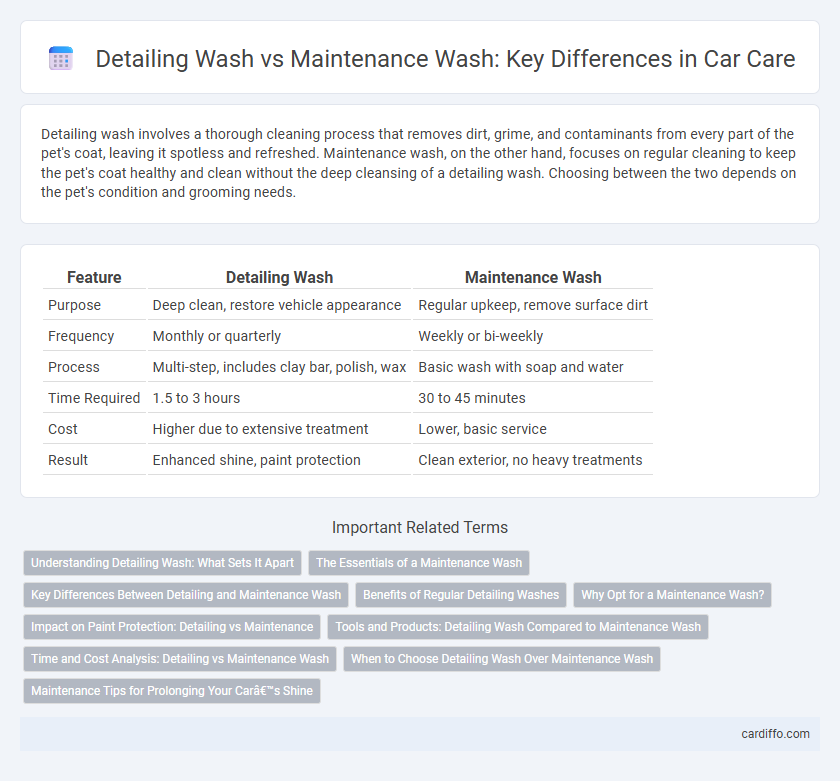Detailing wash involves a thorough cleaning process that removes dirt, grime, and contaminants from every part of the pet's coat, leaving it spotless and refreshed. Maintenance wash, on the other hand, focuses on regular cleaning to keep the pet's coat healthy and clean without the deep cleansing of a detailing wash. Choosing between the two depends on the pet's condition and grooming needs.
Table of Comparison
| Feature | Detailing Wash | Maintenance Wash |
|---|---|---|
| Purpose | Deep clean, restore vehicle appearance | Regular upkeep, remove surface dirt |
| Frequency | Monthly or quarterly | Weekly or bi-weekly |
| Process | Multi-step, includes clay bar, polish, wax | Basic wash with soap and water |
| Time Required | 1.5 to 3 hours | 30 to 45 minutes |
| Cost | Higher due to extensive treatment | Lower, basic service |
| Result | Enhanced shine, paint protection | Clean exterior, no heavy treatments |
Understanding Detailing Wash: What Sets It Apart
Detailing wash involves a thorough cleaning process that targets every part of the vehicle, including hard-to-reach areas, using specialized products and techniques to remove dirt, grime, and contaminants from the paintwork and interior surfaces. This process often includes clay bar treatments, polish applications, and protective wax or sealant layers to restore and preserve the vehicle's finish. In contrast, maintenance wash focuses on routine cleaning to remove surface dirt and maintain the car's appearance between detailing sessions, using standard soap and water without deep cleaning or surface correction.
The Essentials of a Maintenance Wash
A maintenance wash involves regularly cleansing the vehicle's surface to remove dust, dirt, and contaminants that accumulate between thorough detailing sessions, preserving the paint's longevity and shine. Unlike a detailing wash, which includes deep cleaning, clay bar treatment, and polishing, a maintenance wash focuses on gentle soap and water, microfiber mitts, and quick drying to prevent swirl marks and water spots. Performing maintenance washes every two weeks or after exposure to harsh environmental elements ensures optimal protection and extends the interval between comprehensive detailing.
Key Differences Between Detailing and Maintenance Wash
Detailing wash involves a thorough cleaning process targeting every inch of the vehicle, including paint correction, clay bar treatment, and polishing to restore and protect surfaces. Maintenance wash primarily focuses on routine cleaning to remove dirt, dust, and contaminants without intensive restoration steps. The key differences lie in the depth of cleaning, time investment, and the level of surface protection provided by detailing wash compared to the simpler upkeep nature of maintenance wash.
Benefits of Regular Detailing Washes
Regular detailing washes remove embedded dirt, road grime, and contaminants that standard maintenance washes often miss, preserving paint clarity and preventing oxidation. This thorough cleaning process enhances vehicle appearance, prolongs the lifespan of paint and clear coats, and maintains resale value by protecting against environmental damage. Consistent detailing also helps identify minor paint defects early, reducing the need for costly repairs.
Why Opt for a Maintenance Wash?
Maintenance wash offers a practical solution to preserve vehicle cleanliness and protect paintwork by targeting surface contaminants without the need for extensive labor or resources. Unlike detailing washes that involve deep cleaning and restoration, maintenance washes use gentle techniques and products designed for regular upkeep, preventing buildup of dirt and grime. Choosing a maintenance wash extends the longevity of wax or sealant layers, ensuring consistent shine and protection while reducing the frequency and cost of intensive detailing sessions.
Impact on Paint Protection: Detailing vs Maintenance
Detailing wash uses specialized products and techniques to deeply clean and remove contaminants, preserving and enhancing the paint's protective coatings like ceramic or sealants. Maintenance wash focuses on regular, gentle cleaning to prevent dirt build-up and maintain the integrity of existing paint protection without stripping away layers. Properly balancing detailing and maintenance washes can significantly extend the lifespan of paint protection and maintain the vehicle's finish quality.
Tools and Products: Detailing Wash Compared to Maintenance Wash
Detailing wash requires specialized tools such as foam cannons, microfiber wash mitts, and clay bars, paired with high-quality pH-balanced shampoos and detailing sprays designed to remove embedded contaminants without stripping wax or sealants. Maintenance wash uses more basic equipment like standard wash mitts and buckets with grit guards, relying on regular car shampoos formulated for gentle cleaning to preserve the existing protective layers. The difference in product formulation and tool selection directly impacts the effectiveness of contaminant removal and paint protection during each wash type.
Time and Cost Analysis: Detailing vs Maintenance Wash
Detailing wash typically requires 1.5 to 3 hours and costs between $150 and $300 due to its thorough cleaning and paint correction processes. Maintenance wash averages 30 to 45 minutes at a lower cost of $20 to $50, focusing on surface dirt removal without deep cleaning. Time and cost differences highlight detailing wash as a periodic, intensive service, while maintenance wash suits regular upkeep and budget-conscious car care.
When to Choose Detailing Wash Over Maintenance Wash
Detailing wash is ideal when vehicles accumulate stubborn contaminants like tar, tree sap, or heavy dirt that cannot be removed by a maintenance wash. Choose detailing wash during seasonal changes or after long trips to restore paint clarity and protect the finish thoroughly. Maintenance wash suits regular upkeep, while detailing wash targets deep cleaning and paint restoration.
Maintenance Tips for Prolonging Your Car’s Shine
Maintenance wash involves gentle cleaning using pH-balanced shampoos and microfiber mitts to prevent swirl marks and preserve the paint's clarity. Regularly rinsing off contaminants like bird droppings and road salt protects clear coat layers and slows oxidation. Applying a high-quality wax or sealant every few months enhances the vehicle's hydrophobic properties, improving dirt repellency and prolonging the car's showroom shine.
Detailing Wash vs Maintenance Wash Infographic

 cardiffo.com
cardiffo.com